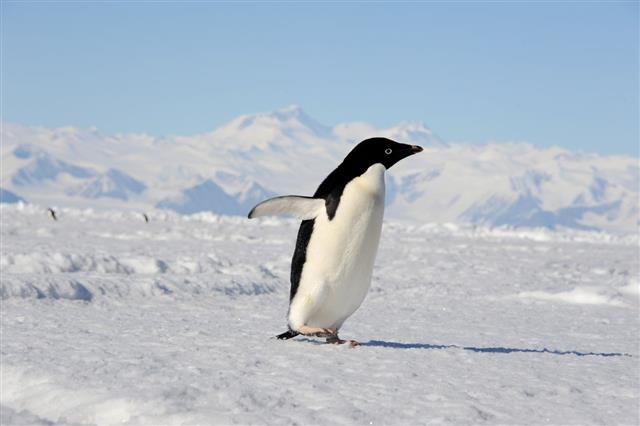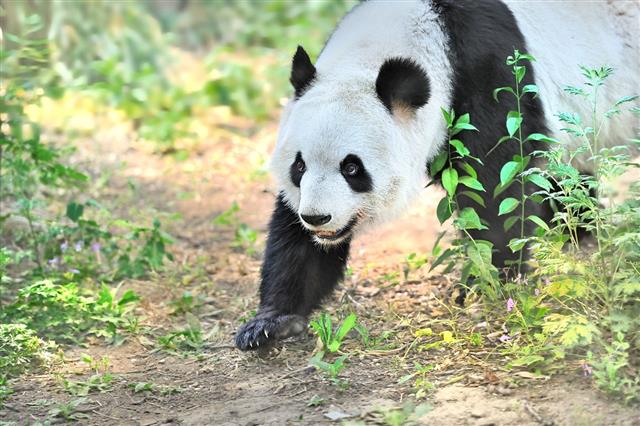
The list of animals that are black and white goes well beyond just zebras and giant pandas. We will not just see which animals sport these shades, but will also see how this unique coloration helps these animals when it comes to survival.
Disruptive Coloration
Disruptive coloration is a camouflage technique, wherein the unique coloration pattern breaks the animal’s outline and makes its difficult for other animals to spot it. As for animals resorting to this technique, the zebra―with its black-and-white stripes―will be an apt example.
When we speak of beautiful animals, we often restrict ourselves to all those colorful species that add to the nature’s palette. We speak of tigers with their magnificent stripes, song birds with their colorful plumage, butterflies with their striking wings, and so on. Seldom do we look at zebras as beautiful. A wildlife photographer or people who work in the field of environment might, but most of us don’t.
How many black-and-white animals can you list? Most people won’t be able to go beyond zebras and giant pandas. Black-and-white animals seldom grab our attention like colorful animals do. A giant panda is famous because it is cute, not because of its beauty or color. The word ‘colorful’ seems to have become synonymous to beautiful for most people out there, and that’s where we are missing out on real beauty.
Giant Panda
The giant panda (Ailuropoda melanoleuca) is a species of bears native to south-central China. Like zebras, giant pandas are also known for their distinct black-and-white appearance. It has black fur on its ears, eye patches, shoulders, and legs, complementing the white fur all over the body. That explains its scientific name Ailuropoda melanoleuca, meaning black and white cat-foot.
It is yet to be ascertained as to how their coloration helps them. One theory is that their appearance blends well in their snow-clad rocky habitat, thus providing them effective camouflage against predators.
Killer Whale
The killer whale, or orca (Orcinus orca), is a top-level predator in the marine biome. Despite its name, it is actually a member of the oceanic dolphin family. The species is found nearly all over the world, and can be identified by its distinct coloration: black back with white chest and sides. Also, there is a white patch above and slightly behind each eye.
The coloration of the killer whale is yet another example of disruptive coloration. The only difference though, is that it helps the animal in predation, by making it difficult for other species to spot it.
Skunk
This black-and-white species of skunk found in North America includes the striped skunk (Mephitis mephitis), eastern spotted skunk (Spilogale putorius), western spotted skunk (Spilogale gracilis), hooded skunk (Mephitis macroura), and American hog-nosed skunk (Conepatus leuconotus). Of these, the striped skunk is the most common, and can be easily identified by its black body, with a white stripe running along either sides, eventually converging at its nape to form a broader white patch.
Even the eastern and western spotted skunks have stripes, but unlike the striped skunk, their stripes are broken. The American hog-nosed skunk, on the other hand, has a single, broad white stripe, extending from its head all the way to the base of its tail. And as for the hooded skunk, it owes its name to the ruff of white fur around its neck.
Malayan Tapir
The Malayan tapir (Tapirus indicus) boasts of being the largest of the five tapir species in the world. Also, it is the only tapir native to Asia. It can be easily identified by its half black and half white appearance. Basically, it is black in color with a white patch extending from its shoulder all the way to its rear. Additionally, its ear tips are also white. The Malayan tapir has been enlisted as an endangered species by the IUCN.
Black-and-white Ruffed Lemur
True to its common name, the black-and-white ruffed lemur (Varecia variegata) has a brilliant mix of these two colors. While its abdomen, tail, hands, feet, inner limbs, forehead, face, and crown are black, its sides, back, hind limbs, and hindquarters have white fur. It is difficult to differentiate between a male and female based on their coloration alone. Yet another interesting fact about the black-and-white ruffed lemur is that, it is the largest extant member of the lemur family.
Eastern Black-and-white Colobus

The eastern black-and-white colobus (Colobus guereza) is one of the five black-and-white colobuses native to Africa. It is mostly black in color, with a thick white outer ring of fur on its face, and long strands of white fur running along either sides of the body. Besides that, there is a strip of white fur along its thigh. Its tail has a tuft of white hair at the end; the length of which differs from one animal to another.
The Geoffroy’s black-and-white colobus (Colobus vellerosus), Angolan black-and-white colobus (Colobus angolensis), and the Satanic black colobus (Colobus satanas) have striking resemblance to the eastern black-and-white. The western black-and-white colobus (Colobus polykomos), however, is an exception, as it only has white fur on its whiskers and chest. In the context of tails, only the Satanic black colobus has a long black tail.
Zebra
There are three extant species of zebras: the plains zebra (Equus quagga), Grevy’s zebra (Equus grevyi), and the mountain zebra (Equus zebra). They are characterized by their black-and-white striped coat. It was previously thought that zebras were white animals with black stripes. More recently, however, researchers have found evidence that suggests that they are black in color with white stripes.
More interestingly, in zebras, stripes are unique to each individual animal; the same way as fingerprints are unique to each human. These black-and-white stripes facilitate the disruptive coloration camouflage technique. When zebras are in a herd, predators find it difficult to single out and attack an individual. Additionally, these stripes also come handy for them when it comes to identification.
California Kingsnake
The California kingsnake (Lampropeltis getula californiae) is a nonvenomous colubrid species native to the western United States and northern Mexico. It mainly comes in shades of black with white markings, giving it an eye-catching coloration.
Though rare, brown California kingsnakes with white markings are also known to exist.
White Tiger
The presence of the tiger in this list of black-and-white animals may come as a surprise for some people, but as you see in the above picture, the white tiger does deserve place in this list. It’s worth noting that the white tiger is not a separate species of tiger as such, but is a mutant variant of the Bengal tiger (Panthera tigris). The Bengal tiger owes its orange-colored fur to the presence of pheomelanin pigment, and therefore, in the absence of this pigment, the animal is rendered white.
Zebra Swallowtail
Not all butterflies are colorful. There are some species that are black and white, and yet, very beautiful. One such species is the zebra swallowtail butterfly (Protographium marcellus), which is found in the eastern United States and southeast Canada. Its black-and-white stripes are similar to that of a zebra, and thus the name. Besides its coloration, the species can be identified by its distinctive wing shape and spectacular long tail.
Paper Kite
Yet another distinctive black-and-white butterfly is the paper kite butterfly (Idea leuconoe), which is found in the Philippines, Malaysia, and the surrounding regions in Southeast Asia. It is mainly white in color, with scattered black spots. Also known as Rice Paper, it is unusually large, with a wingspan of about 6 inches.
Adelie Penguin
Most penguins are black and white in color, but the Adelie penguin (Pygoscelis adeliae) is one species that lives true to this clichéd image of penguins … clichéd because not all penguins are black and white. It is predominantly black in color, with a white belly, as a result of which it appears as if it’s wearing a tuxedo. Furthermore, it has a white patch on its head extending from eye to eye. This species is found all along the Antarctic coast.
Other species of penguins that are predominantly black and white include the Chinstrap penguin (Pygoscelis antarcticus), Fiordland crested penguin (Eudyptes pachyrhynchus), African penguin (Spheniscus demersus), etc.
Black-and-white Warbler
Penguins are not the only black-and-white birds in the world. Yet another example of a species with black-and-white feathers is the black-and-white warbler (Mniotilta varia), lone member of genus Mniotilta. True its name, this World warbler is entirely covered with black-and-white stripes. There are two white wing bars which become apparent when the bird is in flight. Also, undertail coverts of this warbler species have large black spots. While males are mainly dark, females are pale in color.
Sooty Tern
The Sooty tern (Onychoprion fuscatus) can be identified by its black upperparts, legs, and bill, complementing its white underparts. In terms of coloration, it is somewhat similar to the bridled tern (Onychoprion anaethetus) with whom it shares its native habitat. However, it has a darker upperpart than the latter.
There are two subspecies of the sooty tern: the Atlantic sooty tern (Onychoprion fuscatus fuscatus), with its distinct white underparts, and the Indopacific sooty tern (Onychoprion fuscatus nubilosus), with its light-gray or dull-white underparts.
Razorbill
Also black with a white underside is the razorbill (Alca torda), a seabird that only comes to land for breeding. The razorbill has black plumage on its head, neck, and back. Besides that, its feet are also black in color. A closer look and you will see a thin white line extending from its eyes to the end of its bill. Both males and females are identical when it comes to coloration, and therefore, you have to rely on the difference in their size to distinguish them.
Black-billed Magpie
Then there is the black-billed magpie (Pica hudsonia) which is found in abundance in the western parts of North America. This bird is largely black and white, with black feathers on the wings, and black feet and bill, but has a hint of blue or blue-green on its tail. Additionally, there are large white markings on the primaries, i.e., feathers projecting along the outer edge of the bird’s wings, which are clearly visible when the bird is in flight.
Valais Blacknose
The black-and-white coat is not necessarily restricted to wild animals. Even domesticated species sport the elegant combination. The Valais Blacknose breed of sheep, from the Valais region of Switzerland, for instance, is typically characterized by its white, fluffy coat, with a black face, ears, knees, and legs.
Also, a goat breed hailing from this region, the Valais Blackneck, sports a distinct black-and-white coat, with its front half having black fur, and rear half having white fur.
Cows
When we talk of black-and-white cows, two breeds that deserve a mention are the Holstein Friesian breed and the Belted Galloway breed. While the Holstein Friesian breed, which boasts of being the world’s highest-production dairy animal, has black-and-white markings that vary from nearly all black to nearly all white, the Belted Galloway breed of cattle has a distinct broad white belt completely encircling its body.
Dogs
Dogs come in several different colors. When we talk of black-and-white dogs, the first breed to comes to your mind will be the dalmatian. This breed can be easily identified by black spots on a white background. Though dalmatians with brown spots on white do exist, the combination is not as common as black spots on white.
Other breeds include the Guatemalan Dogo, which is white with black markings on the head; Karelian Bear Dog, which is black with white markings; Stabyhouns, which mostly sport a black-and-white coat; etc. Historically, even the French spaniel sported a white coat with black markings.
Besides these dogs, which specifically come with a combination of black-and-white fur, there are other species which come in several color combinations; black and white being one of them.
Cats
Like dogs, even cats come in all types of colors. Some cats are solid-colored, meaning that they are entirely one-colored, while some are bi-colored, meaning that they have two colors―white combined with another color to be precise. Within these bi-colored cats, there are patterns ranging from 1-10. While 1 refers to completely black fur, 10 refers to completely white fur. If the white fur is limited to face, paws, throat, and chest, of an otherwise black cat, then it is called a tuxedo cat.
After going through this list of black-and-white animals with pictures, you would have realized that there are so many animals out there who are just black and white. Need we say more!































































